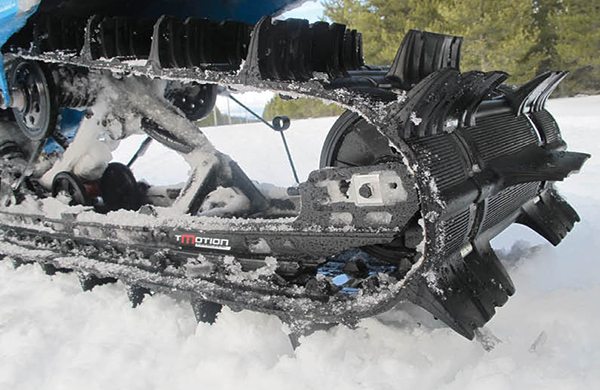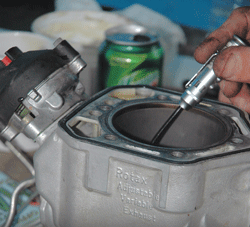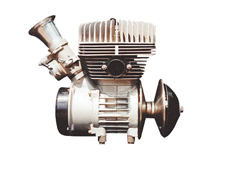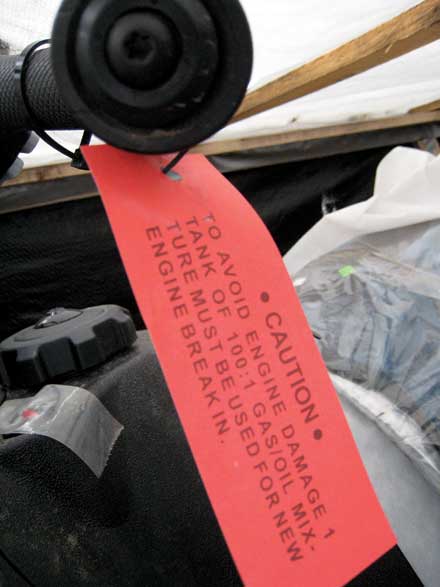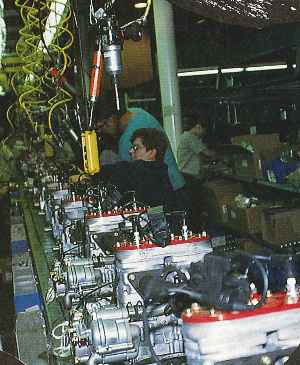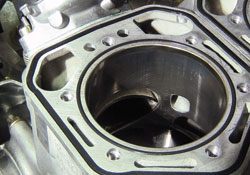
When I got involved with snowmobile racing, I didn’t know much about tuning the snow-and-ice-bound machines. I had a background in motorcycles and had spent many years racing them before I joined the Halvorson Equipment Company’s race team in 1968. I was pressed to come up with modifications that could help the team win more modified racing classes.
I first worked with Tillotson carburetors that had adjustable high-speed and low-speed jets on them. They were pretty crude and not very tunable over the entire operating range of the engines, but they worked.
Having been around motorcycles for many years, I adapted a number of Keihin and Mikuni carburetors for snowmobile engines that I was modifying. These carburetors were more tunable and provided more accurate fuel delivery. I also fiddled around with some early mechanical fuel injection systems, but they never proved to be reliable.
Fast forward some 30 years. Now with tighter emissions regulations and modern electronic fuel injection (EFI) systems, the days of tearing into a Mikuni carburetor to dial-in a sled for the conditions or modifications are mostly behind us. That’s not to say a two-stroke snowmobile engine can’t be fine-tuned, but nowadays fuel calibrations for injected engines are done with aftermarket electronic fuel injection modules.
Sensors, Maps, Signals and Injectors
While EFI has been around on snowmobiles for quite a few years, the recent Environmental Protection Agency standards are almost making the advanced fuel induction technology a necessity. The Ord Systems I worked with in the 1960s and ’70s used a simple cam to adjust fuel/air ratios throughout the throttle range; you could say the system had a very early throttle position sensor.
With modern EFI systems, the engine management computers receive inputs from sensors all around the engine that tell the engine’s computer — also called the electronic control module (ECM) — how to adjust the ignition timing and fuel/air ratio. Even some carbureted sleds, such as the Rotax PowerTEK engines, have an ECM that partially controls fuel delivery.
Depending upon whether the engine is a four-stroke or two-stroke, the sensor inputs will include coolant temperature, crankshaft position, exhaust-port valve position, oil pressure, camshaft position, manifold air pressure/temperature, idle air control valve, throttle position, detonation, atmospheric pressure and in the case of a number of Arctic Cat and Polaris two-stroke engines, which, like all two-strokes, are sensitive to changes in the tune of the exhaust expansion chambers, a pipe temperature sensor.
Engineers create maps that read all these inputs and adjust the ignition timing and fuel/air mixture from start-up to full throttle at full load. The maps, which are read by the computer, effectively change the “jetting” of the fuel delivery system based on the operating conditions. If a manufacturer changes the map in its ECM after production, it usually provides the update to its dealers who have proprietary software that can communicate with the ECM. There is nothing you can do in your garage to change the fuel delivery on these EFI systems, but you can change the signals that go from the ECM to the fuel injectors.
Aftermarket Control Boxes
Starting Line Products Inc. (SLP), which sells many snowmobile modification components, had to find a product that allowed its tuners to change fuel delivery ratios for their modifications.
I spoke with operations manager Jerry Mathews at SLP about two control boxes that his Idaho Falls, Idaho-based shop uses: the Dynojet Research Power Commander and Boondocker Control Box. These same control boxes are used by most aftermarket performance shops. Both of these modules modify only the signals coming from the ECM that control the fuel injectors. Ignition timing cannot be adjusted through these aftermarket boxes. They do not modify any of the maps used by the ECM, nor do they alter any of the ECM’s operations.
The control boxes are installed in series with the lead coming from the ECM and connecting to the fuel injector. The final signal output from the ECM to the fuel injector is a series of pulses that vary the length of the electrical pulse that opens the injector nozzle: the longer the pulse, the richer the mixture; the shorter the pulse, the leaner the mixture.
The major difference between the two control boxes is the amount of control a person has over fuel delivery. The Power Commander allows a tuner to vary the mixture at 225 points between 1500 and 7500 rpm, while the Boondocker allows adjustment at 18 points through the usable power band. There are other considerations when looking for a control box to adjust fuel mixtures on an EFI-equipped snowmobile, such as using nitrous oxide along with gasoline. Some boxes are designed to handle that task while others are not.
The aftermarket control boxes allow tuners to vary the fuel/air mixture at various rpm without having to use a laptop or PDA, or create a new fuel map. Control boxes are not available for all EFI systems on the market. No one, for instance, has taken on dealing with adjusting fuel mixture on BRP’s E-TEC direct injection system.
Ready To Modify?
First, Get Informed!
The manufacturers are doing a wonderful job of developing maps that control the fuel delivery based on the sensor inputs. There are a few models out there that can be cleaned up and improved a bit, but generally there is no need to change the fuel delivery or ignition timing on a stock engine. But if you own or want to build a modified, fuel-injected engine, you’ll need a control box to adjust fuel delivery.
It is imperative that you talk with a representative of the aftermarket company you are working with to determine which system will best serve your engine’s needs. These companies have done a lot of testing with the systems and can help you decide how to get the best, most reliable performance. After you gain an understanding of how these electronic control boxes operate, you’ll find they’re actually a lot easier to work with than changing jets in a carburetor.

